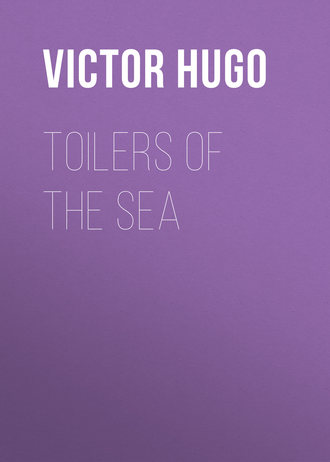
Виктор Мари Гюго
Toilers of the Sea
PART II. – MALICIOUS GILLIATT
BOOK I
THE ROCK
I
THE PLACE WHICH IS DIFFICULT TO REACH, AND DIFFICULT TO LEAVE
The bark which had been observed at so many points on the coast of Guernsey on the previous evening was, as the reader has guessed, the old Dutch barge or sloop. Gilliatt had chosen the channel along the coast among the rocks. It was the most dangerous way, but it was the most direct. To take the shortest route was his only thought. Shipwrecks will not wait; the sea is a pressing creditor; an hour's delay may be irreparable. His anxiety was to go quickly to the rescue of the machinery in danger.
One of his objects in leaving Guernsey was to avoid arousing attention. He set out like one escaping from justice, and seemed anxious to hide from human eyes. He shunned the eastern coast, as if he did not care to pass in sight of St. Sampson and St. Peter's Port, and glided silently along the opposite coast, which is comparatively uninhabited. Among the breakers, it was necessary to ply the oars; but Gilliatt managed them on scientific principles; taking the water quietly, and dropping it with exact regularity, he was able to move in the darkness with as little noise and as rapidly as possible. So stealthy were his movements, that he might have seemed to be bent upon some evil errand.
In truth, though embarking desperately in an enterprise which might well be called impossible, and risking his life with nearly every chance against him, he feared nothing but the possibility of some rival in the work which he had set before him.
As the day began to break, those unknown eyes which look down upon the world from boundless space might have beheld, at one of the most dangerous and solitary spots at sea, two objects, the distance between which was gradually decreasing, as the one was approaching the other. One, which was almost imperceptible in the wide movement of the waters, was a sailing boat. In this was a man. It was the sloop. The other, black, motionless, colossal, rose above the waves, a singular form. Two tall pillars issuing from the sea bore aloft a sort of cross-beam which was like a bridge between them. This bridge, so singular in shape that it was impossible to imagine what it was from a distance, touched each of the two pillars. It resembled a vast portal. Of what use could such an erection be in that open plain, the sea, which stretched around it far and wide? It might have been imagined to be a Titanic Cromlech, planted there in mid-ocean by an imperious whim, and built up by hands accustomed to proportion their labours to the great deep. Its wild outline stood well-defined against the clear sky.
The morning light was growing stronger in the east; the whiteness in the horizon deepened the shadow on the sea. In the opposite sky the moon was sinking.
The two perpendicular forms were the Douvres. The huge mass held fast between them, like an architrave between two pillars, was the wreck of the Durande.
The rock, thus holding fast and exhibiting its prey, was terrible to behold. Inanimate things look sometimes as if endowed with a dark and hostile spirit towards man. There was a menace in the attitude of the rocks. They seemed to be biding their time.
Nothing could be more suggestive of haughtiness and arrogance than their whole appearance: the conquered vessel; the triumphant abyss. The two rocks, still streaming with the tempest of the day before, were like two wrestlers sweating from a recent struggle. The wind had sunk; the sea rippled gently; here and there the presence of breakers might be detected in the graceful streaks of foam upon the surface of the waters. A sound came from the sea like the murmuring of bees. All around was level except the Douvres, rising straight, like two black columns. Up to a certain height they were completely bearded with seaweed; above this their steep haunches glittered at points like polished armour. They seemed ready to commence the strife again. The beholder felt that they were rooted deep in mountains whose summits were beneath the sea. Their aspect was full of a sort of tragic power.
Ordinarily the sea conceals her crimes. She delights in privacy. Her unfathomable deeps keep silence. She wraps herself in a mystery which rarely consents to give up its secrets. We know her savage nature, but who can tell the extent of her dark deeds? She is at once open and secret; she hides away carefully, and cares not to divulge her actions; wrecks a vessel, and, covering it with the waves, engulfs it deep, as if conscious of her guilt. Among her crimes is hypocrisy. She slays and steals, conceals her booty, puts on an air of unconsciousness, and smiles.
Here, however, was nothing of the kind. The Douvres, lifting above the level of the waters the shattered hull of the Durande, had an air of triumph. The imagination might have pictured them as two monstrous arms, reaching upwards from the gulf, and exhibiting to the tempest the lifeless body of the ship. Their aspect was like that of an assassin boasting of his evil deeds.
The solemnity of the hour contributed something to the impression of the scene. There is a mysterious grandeur in the dawn, as of the border-land between the region of consciousness and the world of our dreams. There is something spectral in that confused transition time. The immense form of the two Douvres, like a capital letter H, the Durande forming its cross stroke, appeared against the horizon in all their twilight majesty.
Gilliatt was attired in his seaman's clothing: a Guernsey shirt, woollen stockings, thick shoes, a homespun jacket, trousers of thick stuff, with pockets, and a cap upon his head of red worsted, of a kind then much in use among sailors, and known in the last century as a galérienne.
He recognised the rocks, and steered towards them.
The situation of the Durande was exactly the contrary of that of a vessel gone to the bottom: it was a vessel suspended in the air.
No problem more strange was ever presented to a salvor.
It was broad daylight when Gilliatt arrived in the waters about the rock.
As we have said, there was but little sea. The slight agitation of the water was due almost entirely to its confinement among the rocks. Every passage, small or large, is subject to this chopping movement. The inside of a channel is always more or less white with foam. Gilliatt did not approach the Douvres without caution.
He cast the sounding lead several times.
He had a cargo to disembark.
Accustomed to long absences, he had at home a number of necessaries always ready. He had brought a sack of biscuit, another of rye-meal, a basket of salt fish and smoked beef, a large can of fresh water; a Norwegian chest painted with flowers, containing several coarse woollen shirts, his tarpaulin and his waterproof overalls, and a sheepskin which he was accustomed to throw at night over his clothes. On leaving the Bû de la Rue he had put all these things hastily into the barge, with the addition of a large loaf. In his hurry he had brought no other tools but his huge forge-hammer, his chopper and hatchet, and a knotted rope. Furnished with a grappling-iron and with a ladder of that sort, the steepest rocks become accessible, and a good sailor will find it possible to scale the rudest escarpment. In the island of Sark the visitor may see what the fishermen of the Havre Gosselin can accomplish with a knotted cord.
His nets and lines and all his fishing apparatus were in the barge. He had placed them there mechanically and by habit; for he intended, if his enterprise continued, to sojourn for some time in an archipelago of rocks and breakers, where fishing nets and tackle are of little use.
At the moment when Gilliatt was skirting the great rock the sea was retiring; a circumstance favourable to his purpose. The departing tide laid bare, at the foot of the smaller Douvre, one or two table-rocks, horizontal, or only slightly inclined, and bearing a fanciful resemblance to boards supported by crows. These table-rocks, sometimes narrow, sometimes broad, standing at unequal distances along the side of the great perpendicular column, were continued in the form of a thin cornice up to a spot just beneath the Durande, the hull of which stood swelling out between the two rocks. The wreck was held fast there as in a vice.
This series of platforms was convenient for approaching and surveying the position. It was convenient also for disembarking the contents of the barge provisionally; but it was necessary to hasten, for it was only above water for a few hours. With the rising tide the table-rocks would be again beneath the foam.
It was before these table-rocks, some level, some slanting, that Gilliatt pushed in and brought the barge to a stand. A thick mass of wet and slippery sea-wrack covered them, rendered more slippery here and there by their inclined surfaces.
Gilliatt pulled off his shoes and sprang bare-footed on to the slimy weeds, and made fast the barge to a point of rock.
Then he advanced as far as he could along the granite cornice, reached the rock immediately beneath the wreck, looked up, and examined it.
The Durande had been caught suspended, and, as it were, fitted in between the two rocks, at about twenty feet above the water. It must have been a heavy sea which had cast her there.
Such effects from furious seas have nothing surprising for those who are familiar with the ocean. To cite one example only: – On the 25th January 1840, in the Gulf of Stora, a tempest struck with its expiring force a brig, and casting it almost intact completely over the broken wreck of the corvette La Marne, fixed it immovable, bowsprit first, in a gap between the cliffs.
The Douvres, however, held only a part of the Durande.
The vessel snatched from the waves had been, as it were, uprooted from the waters by the hurricane. A whirlwind had wrenched it against the counteracting force of the rolling waves, and the vessel thus caught in contrary directions by the two claws of the tempest had snapped like a lath. The after-part with the engine and the paddles, lifted out of the foam and driven by all the fury of the cyclone into the defile of the Douvres, had plunged in up to her midship beam, and remained there. The blow had been well directed. To drive it in this fashion between the two rocks, the storm had struck it as with an enormous hammer. The forecastle carried away and rolled down by the sea, had gone to fragments among the breakers.
The hold, broken in, had scattered out the bodies of the drowned cattle upon the sea.
A large portion of the forward side and bulwarks still hung to the riders by the larboard paddle-box, and by some shattered braces easy to strike off with the blow of a hatchet.
Here and there, among beams, planks, rags of canvas, pieces of chains, and other remains of wreck were seen lying about among the rugged fragments of shattered rock.
Gilliatt surveyed the Durande attentively. The keel formed a roofing over his head.
A serene sky stretched far and wide over the waters, scarcely wrinkled with a passing breath. The sun rose gloriously in the midst of the vast azure circle.
From time to time a drop of water was detached from the wreck and fell into the sea.
II
A CATALOGUE OF DISASTERS
The Douvres differed in shape as well as in height.
Upon the Little Douvre, which was curved and pointed, long veins of reddish-coloured rock, of a comparatively soft kind, could be seen branching out and dividing the interior of the granite. At the edges of these red dykes were fractures, favourable to climbing. One of these fractures, situated a little above the wreck, had been so laboriously worn and scooped out by the splashing of the waves, that it had become a sort of niche, in which it would have been quite possible to place a statue. The granite of the Little Douvre was rounded at the surface, and, to the feel at least, soft like touchstone; but this feeling detracted nothing from its durability. The Little Douvre terminated in a point like a horn. The Great Douvre, polished, smooth, glossy, perpendicular, and looking as if cut out by the builder's square, was in one piece, and seemed made of black ivory. Not a hole, not a break in its smooth surface. The escarpment looked inhospitable. A convict could not have used it for escape, nor a bird for a place for its nest. On the summit there was a horizontal surface as upon "The Man Rock;" but the summit of the Great Douvre was inaccessible.
It was possible to scale the Little Douvre, but not to remain on the summit; it would have been possible to rest on the summit of the Great Douvre, but impossible to scale it.
Gilliatt, having rapidly surveyed the situation of affairs, returned to the barge, landed its contents upon the largest of the horizontal cornice rocks, made of the whole compact mass a sort of bale, which he rolled up in tarpaulin, fitted a sling rope to it with a hoisting block, pushed the package into a corner of the rocks where the waves could not reach it, and then clutching the Little Douvre with his hands, and holding on with his naked feet, he clambered from projection to projection, and from niche to niche, until he found himself level with the wrecked vessel high up in the air.
Having reached the height of the paddles, he sprang upon the poop.
The interior of the wreck presented a mournful aspect.
Traces of a great struggle were everywhere visible. There were plainly to be seen the frightful ravages of the sea and wind. The action of the tempest resembles the violence of a band of pirates. Nothing is more like the victim of a criminal outrage than a wrecked ship violated and stripped by those terrible accomplices, the storm-cloud, the thunder, the rain, the squall, the waves, and the breakers.
Standing upon the dismantled deck, it was natural to dream of the presence of something like a furious stamping of the spirits of the storm. Everywhere around were the marks of their rage. The strange contortions of certain portions of the ironwork bore testimony to the terrific force of the winds. The between-decks were like the cell of a lunatic, in which everything has been broken.
No wild beast can compare with the sea for mangling its prey. The waves are full of talons. The north wind bites, the billows devour, the waves are like hungry jaws. The ocean strikes like a lion with its heavy paw, seizing and dismembering at the same moment.
The ruin conspicuous in the Durande presented the peculiarity of being detailed and minute. It was a sort of horrible stripping and plucking. Much of it seemed done with design. The beholder was tempted to exclaim, "What wanton mischief!" The ripping of the planking was edged here and there artistically. This peculiarity is common with the ravages of the cyclone. To chip and tear away is the caprice of the great devastator. Its ways are like those of the professional torturer. The disasters which it causes wear a look of ingenious punishments. One might fancy it actuated by the worst passions of man. It refines in cruelty like a savage. While it is exterminating it dissects bone by bone. It torments its victim, avenges itself, and takes delight in its work. It even appears to descend to petty acts of malice.
Cyclones are rare in our latitudes, and are, for that reason, the more dangerous, being generally unexpected. A rock in the path of a heavy wind may become the pivot of a storm. It is probable that the squall had thus rotated upon the point of the Douvres, and had turned suddenly into a waterspout on meeting the shock of the rocks, a fact which explained the casting of the vessel so high among them. When the cyclone blows, a vessel is of no more weight in the wind than a stone in a sling.
The damage received by the Durande was like the wound of a man cut in twain. It was a divided trunk from which issued a mass of débris like the entrails of a body. Various kinds of cordage hung floating and trembling, chains swung chattering; the fibres and nerves of the vessel were there naked and exposed. What was not smashed was disjointed.
Fragments of the sheeting resembled currycombs bristling with nails; everything bore the appearance of ruin; a handspike had become nothing but a piece of iron; a sounding-lead, nothing but a lump of metal; a dead-eye had become a mere piece of wood; a halliard, an end of rope; a strand of cord, a tangled skein; a bolt-rope, a thread in the hem of a sail. All around was the lamentable work of demolition. Nothing remained that was not unhooked, unnailed, cracked, wasted, warped, pierced with holes, destroyed: nothing hung together in the dreadful mass, but all was torn, dislocated, broken. There was that air of drift which characterises the scene of all struggles – from the melées of men, which are called battles, to the melées of the elements, to which we give the name of chaos. Everything was sinking and dropping away; a rolling mass of planks, panelling, ironwork, cables, and beams had been arrested just at the great fracture of the hull, whence the least additional shock must have precipitated them into the sea. What remained of her powerful frame, once so triumphant, was cracked here and there, showing through large apertures the dismal gloom within.
The foam from below spat its flakes contemptuously upon this broken and forlorn outcast of the sea.
III
SOUND; BUT NOT SAFE
Gilliatt did not expect to find only a portion of the ship existing. Nothing in the description, in other respects so precise, of the captain of the Shealtiel had led him to anticipate this division of the vessel in the centre. It was probable that the "diabolical crash" heard by the captain of the Shealtiel marked the moment when this destruction had taken place under the blows of a tremendous sea. The captain had, doubtless, worn ship just before this last heavy squall; and what he had taken for a great sea was probably a waterspout. Later, when he drew nearer to observe the wreck, he had only been able to see the stern of the vessel – the remainder, that is to say, the large opening where the fore-part had given way, having been concealed from him among the masses of rock.
With that exception, the information given by the captain of the Shealtiel was strictly correct. The hull was useless, but the engine remained intact.
Such chances are common in the history of shipwreck. The logic of disaster at sea is beyond the grasp of human science.
The masts having snapped short, had fallen over the side; the chimney was not even bent. The great iron plating which supported the machinery had kept it together, and in one piece. The planks of the paddle-boxes were disjointed, like the leaves of wooden sunblinds; but through their apertures the paddles themselves could be seen in good condition. A few of their floats only were missing.
Besides the machinery, the great stern capstan had resisted the destruction. Its chain was there, and, thanks to its firm fixture in a frame of joists, might still be of service, unless the strain of the voyal should break away the planking. The flooring of the deck bent at almost every point, and was tottering throughout.
On the other hand, the trunk of the hull, fixed between the Douvres, held together, as we have already said, and it appeared strong.
There was something like derision in this preservation of the machinery; something which added to the irony of the misfortune. The sombre malice of the unseen powers of mischief displays itself sometimes in such bitter mockeries. The machinery was saved, but its preservation did not make it any the less lost. The ocean seemed to have kept it only to demolish it at leisure. It was like the playing of the cat with her prey.
Its fate was to suffer there and to be dismembered day by day. It was to be the plaything of the savage amusements of the sea. It was slowly to dwindle, and, as it were, to melt away. For what could be done? That this vast block of mechanism and gear, at once massive and delicate, condemned to fixity by its weight, delivered up in that solitude to the destructive elements, exposed in the gripe of the rock to the action of the wind and wave, could, under the frown of that implacable spot, escape from slow destruction, seemed a madness even to imagine.
The Durande was the captive of the Douvres.
How could she be extricated from that position?
How could she be delivered from her bondage?
The escape of a man is difficult; but what a problem was this – the escape of a vast and cumbrous machine.







